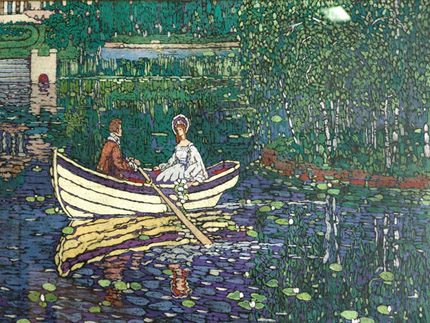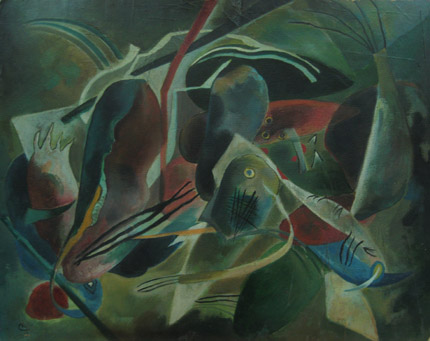 home
about
artists
exhibitions press
contact
purchase
home
about
artists
exhibitions press
contact
purchase |
|
|
|
WASSILY KANDINSKY (1866-1944) Wassily Wassilyevich Kandinsky (16 December 1866 – 13 December 1944) was an influential Russian painter and art theorist. He is credited with painting the first purely abstract works. Born in Moscow, Kandinsky spent his childhood in Odessa. He enrolled at the University of Moscow, studying law and economics. Successful in his profession—he was offered a professorship (chair of Roman Law) at the University of Dorpat—he began painting studies (life-drawing, sketching and anatomy) at the age of 30. In 1896 Kandinsky settled in Munich, studying first at Anton Ažbe's private school and then at the Academy of Fine Arts. He returned to Moscow in 1914, after the outbreak of World War I. Kandinsky was unsympathetic to the official theories on art in Moscow, and returned to Germany in 1921. There, he taught at the Bauhaus school of art and architecture from 1922 until the Nazis closed it in 1933. He then moved to France where he lived the rest of his life, became a French citizen in 1939, and produced some of his most prominent art. He died at Neuilly-sur-Seine in 1944. Kandinsky's creation of purely abstract work followed a long period of development and maturation of intense thought based on his artistic experiences. He called this devotion to inner beauty, fervor of spirit, and spiritual desire inner necessity; it was a central aspect of his art. Living in a small apartment in Paris, Kandinsky created his work in a living-room studio. Biomorphic forms with supple, non-geometric outlines appear in his paintings—forms which suggest microscopic organisms but express the artist's inner life. Kandinsky used original colour compositions, evoking Slavic popular art. He also occasionally mixed sand with paint to give a granular, rustic texture to his paintings. This period corresponds to a synthesis of Kandinsky's previous work in which he used all elements, enriching them. In 1936 and 1939 he painted his two last major compositions, the type of elaborate canvases he had not produced for many years. Composition IX has highly contrasted, powerful diagonals whose central form gives the impression of an embryo in the womb. Small squares of colours and coloured bands stand out against the black background of Composition X as star fragments (or filaments), while enigmatic hieroglyphs with pastel tones cover a large maroon mass which seems to float in the upper-left corner of the canvas. In Kandinsky’s work some characteristics are obvious, while certain touches are more discrete and veiled; they reveal themselves only progressively to those who deepen their connection with his work. He intended his forms (which he subtly harmonized and placed) to resonate with the observer's soul. From Wikipedia |
|
|
E-mail: info@hayhillgallery.com |

